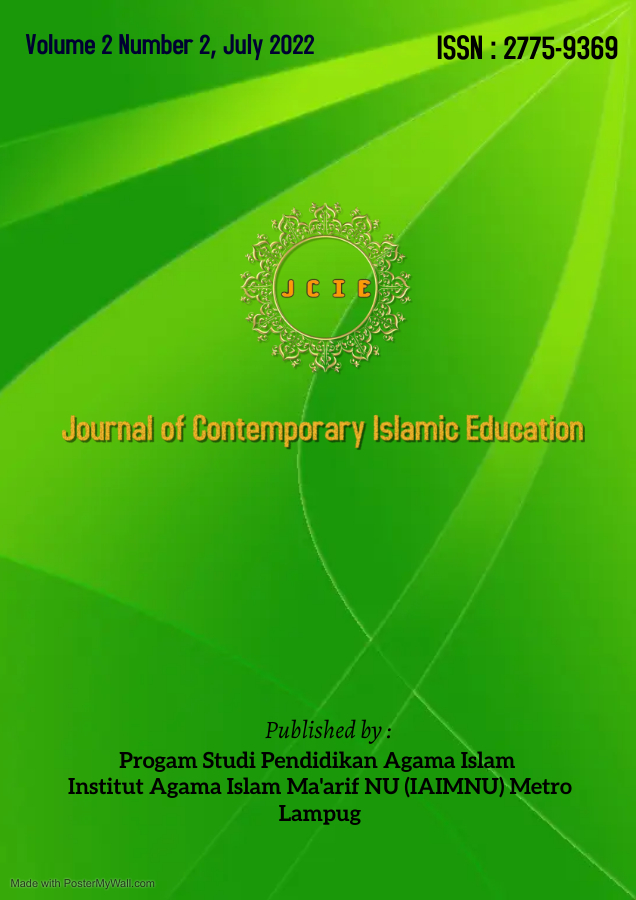The Urgence of Siti Bariyah's Thinking in Islamic Education 5.0
DOI:
https://doi.org/10.25217/jcie.v2i2.2579Abstract
Siti Bariyah is one of the female figures who has many roles in the development of Muhammadiyah and helped the process of forming a women's organization under the auspices of Muhammadiyah, namely 'Aisyiyah. Siti Bariyah's thoughts can be seen from her contribution to Muhammadiyah, especially in the world of education. This study uses a biographical and social approach. The concept used in this research is the concept of gait. The concept used in this research is the concept of social role theory proposed by Erving Goffman. The method used in this research is the historical method. The historical method used in this research consists of four stages, namely; heuristics, verification, interpretation, and historiography. Siti Bariyah was born in Kauman Village, Yogyakarta on 1325 H/1906 AD and died around 1931 AD. She was active in the Sapa Trisno, Wal Ashri¸ and Maghribi School associations which became the embryo of the 'Aisyiyah movement. He is known to have a high intellect. Siti Bariyah's intellectuality made her have many roles in 'Aisyiyah, especially in the fields of religion, social, and education. Her role in the social field was to help pioneer the Suara 'Aisyiyah magazine, to co-found the Female Student Praja, and to initiate the formation of a federation of women's organizations. His role in the field of education is to participate in initiating the establishment of a kindergarten called Frobelschool and participate in eradicating illiteracy. Eradication of letters in the current era can be interpreted as eradicating language illiteracy, namely English and Arabic. The formation of kindergarten as a cadre of intellectual scholars in the face of the era of disruption.
Keywords: Urgency, Siti Bariyah, Islamic Education
References
Abrori, M. S., & Hadi, M. S. (2020). Integral Values in Madrasah: to Foster Community Trust in Education. Istawa : Jurnal Pendidikan Islam, 5(2), 160–178. 10.24269/ijpi.v5i2.2736
Abrori, M. S., Hadi, M. S., & Amrulloh, A. K. (2020). أنماط تطوير المناهج الدراسية وتنفيذها في التربية الدينية الإسلامية في المدرسة المتوسطة المحمدية 1 ديفوك يوكياكرتا. Lentera Pendidikan: Jurnal Ilmu Tarbiyah Dan Keguruan, 23(1), 183–193. https://doi.org/10.24252/lp.2020v23n1i15
Abrori, M. S., Ikhwan, A., Arifin, Z., Setiawan, D., Suwanto, S., & Pambudi, S. (2022). The Islamic Values Of Karaton Ngayogyakarta Hadiningrat Culture. Edukasia Islamika, 7(1). https://doi.org/10.28918/jei.v7i1.4533
Abrori, M. S., & Nurkholis, M. (2019). Islamisasi Ilmu Pengetahuan Menurut Pandangan Syed Muhammad Naquib Al-Attas Dan Implikasinya Terhadap Pengembangan PAI Di Perguruan Tinggi Umum. Al-I’tibar : Jurnal Pendidikan Islam, 6(1), 09–18. https://doi.org/10.30599/jpia.v6i1.419
Amran, M., Sahabuddin, E. S., & Muslimin, M. (2018). Peran Pendidikan Karakter di Sekolah Dasar. Prosiding Seminar Nasional Administrasi Pendidikan Dan Manajemen Pendidikan" Pemberdayaan Pendidik Dan Tenaga Kependidikan Menuju Era Disrupsi Teknologi", 254–261. Google Scholar
Annisa, N. (2012). Preferensi Filantropi Perempuan pada Nasyiatul Aisyiyah di Jawa Timur. Jurnal Indo-Islamika, 1(2), 273–309. http://dx.doi.org/10.15408/idi.v2i2.1178
Arif, S. (2019). Ibn ‘Arabi and The Ambiguous Verses of the Quran: Beyond The Letter and Pure Reason. DINIKA: Academic Journal of Islamic Studies, 4(2), 225–248. https://doi.org/10.22515/dinika.v4i2.1711
Das, S., & Choudhury, P. (2020). Evaluation of perceived speech quality for VoIP codecs under different loudness and background noise condition. Proceedings of the 21st International Conference on Distributed Computing and Networking, 1–5. https://doi.org/10.1145/3369740.3372774
Dewi, K. H. (2008). Perspective versus practice: women’s leadership in Muhammadiyah. Sojourn: Journal of Social Issues in Southeast Asia, 23(2), 161–185. Google Scholar
Ensiklopedi Muhammadiyah. (1923). Muhammadiyah. Internet web
Indonesia, K. W. (1986). Sejarah Setengah Abad Kesatuan Pergerakan Wanita Indonesia. Jakarta. Balai Pustaka. Google Scholar
Irwanto, D., & Alian, S. (2014). Metodologi dan historiografi sejarah. Eja_Publisher, Yogyakarta. Google Scholar
Khomaeny, E. F. F. (2019). TK Aisyiyah Bustanul Athfal: Dulu, Kini, Dan Esok (Refleksi Kiprah Satu Abad TK ABA dalam Membangun Negeri). EDU PUBLISHER. Google Scholar
Kuntowijoyo, K. (2003). Metodologi Sejarah, edisi kedua. Yogyakarta: Tiara Wacana. Google Scholar
Mu’arif, S. (2014). Srikandi-srikandi Aisyiyah. Suara Muhammadiyah. Yogyakarta. Google Scholar
Nashir, H. (2010). Muhammadiyah gerakan pembaruan. Suara Muhammadiyah. Google Scholar
Nastiti, F. E., & Ni’mal‘Abdu, A. R. (2020). Kesiapan pendidikan Indonesia menghadapi era society 5.0. Jurnal Kajian Teknologi Pendidikan, 5(1), 61–66. Google Scholar
Nur’aini, D. S., Hidayat, S., & Basri, M. M. (2015). Corak Pemikiran Dan Gerakan Dakwah Aisyiyah Pada Periode Awal (1917-1945). Universitas Muhammadiyah Surakarta. Google Scholar
Penyusun, T. (2013). Muhammadiyah 100 Tahun Menyinari Negeri. Yogyakarta: Majelis Pustaka Dan Informasi Pimpinan Pusat Muhammadiyah. Google Scholar
Suara ’Asyiyah. (1927). Muhammadiyah. Internet Web
Suminto, S., & Arinatussadiyah, A. (2020). The An-Nahdliyah and The Yanbu’a Method in Learning to Read the Qur’an in the Vocational High School: Comparative Study. Istawa: Jurnal Pendidikan Islam, 5(1), 62–80. https://doi.org/10.24269/ijpi.v5i1.2497
Downloads
Published
How to Cite
Issue
Section
License
Copyright (c) 2022 Anjas Pratiwi, M. Solikul Hadi

This work is licensed under a Creative Commons Attribution-ShareAlike 4.0 International License.





